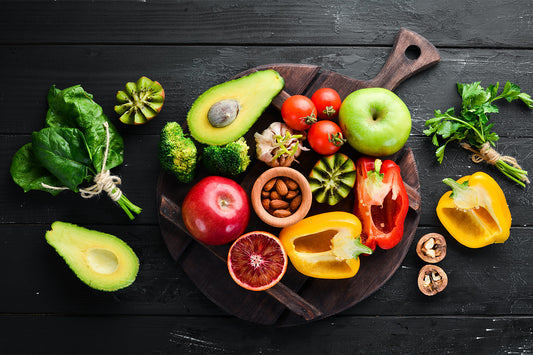Agriculture is a standard part of our daily lives, as it keeps our plates full of food, but we cannot take this process for granted. Ineffective farming practices can threaten our future food supply by limiting our ability to produce food at a scale necessary to support the world’s population.
Fortunately, more mindful practices may be changing the way that we eat while also protecting our food production in the future. By understanding where our food comes from and exploring more sustainable practices, we can support better production systems with our everyday decisions.
What Is Sustainable Agriculture?
Sustainable agriculture is a comprehensive approach to farming that helps to meet food demand for present and future generations while protecting natural resources, maintaining the health of the environment, and ensuring profitability. A key part of sustainable agriculture is supporting the farming families and communities that produce the foods we eat.
Some of the goals and principles of sustainable agriculture include:
- Promoting soil health and preventing soil erosion
- Using water wisely
- More efficient land use
- Increasing resilience to extreme weather events
- Promoting biodiversity
- Ensuring access to food for all communities
- Enhancing the livelihoods of communities that produce food
Why Is Sustainable Farming Important?

Our food supply depends on agriculture, and it is crucial that we farm responsibly. There are already many factors that can impact our food supply, like weather and population stress. From the threat of climate change to the demand of a growing world population, sustainable farming is crucial for maintaining a steady food supply and supporting billions of people.
Because agriculture supports so many people and is such a large industry, it can also negatively affect the surrounding areas because of factors like runoff and resource stress. As a result, it is vital that we balance increased productivity with lower environmental impacts to protect surrounding communities and the planet as a whole. Sustainable farming leads to responsible stewardship of our natural resources by preserving them for other uses, both now and in the future.
The good news is that embracing simple changes in farming practices and new technology can have a major role in protecting our global food supply both now and in the future. The even better news is that many of these changes are already happening. Policymakers are slowly starting to address the importance of sustainable farming with incentives, and we are starting to see results.
What Are Examples of Sustainable Farming Practices?
Improving the sustainability of farming systems has been a priority for scientists for years now. As a result, we already see improved on-farm technologies and practices bolstering our current food production. The following sustainable agricultural practices play a valuable part in supporting a stable food system and changing the way we eat.
Smart Fertilizers
Smart fertilizers are gaining increasing recognition as vital tools in sustainable agriculture. These fertilizers are designed to release nutrients into soil at a slow, controlled rate. Conventional fertilizers can be lost due to factors like water runoff and leaching, which not only leads to smaller crop yields but can also lead to environmental pollution in the surrounding areas and watersheds.
Smart fertilizers offer several benefits, which include enhancing the nutrient efficiency of crops and promoting better water retention in the soil. As a result, these fertilizers allow for more resilient crops to factors like weather and erosion while also requiring the input of fewer natural resources.
These fertilizers are just one example of how new technology can promote sustainable farming. Other examples, like using renewable energy to provide electricity for a farm, can also have a large impact.
Crop Rotation
Crop rotation is a valuable tool for increasing agricultural productivity and protecting the health of farmland. Crop rotation is the practice of planting a different crop in a specific plot of land during different growing seasons. Rotation helps to replenish the nutrients in farmed fields and promote stronger soil fertility, as different plants use different nutrients. For example, some plants, like corn, pull a lot of nitrogen from the soil, while some plants, like soy beans, can actually add nitrogen back to the soil for the next round of corn crop.
Rotation also supports healthy soil by controlling erosion and improving pest management. Soil health is crucial for producing healthy crops and nutrient-rich foods to sustain us. By emphasizing the health of the soil, crop rotation helps produce more nutritious crops and supports higher yields without draining the land of its ability to produce.
Part of a good crop rotation cycle involves planting cover crops. These crops help to naturally slow erosion, improve water retention, boost soil health, and control pests. By attracting pollinators and improving crop diversity, cover crops help to increase crop yields and add organic matter to the soil during tillage. Agroforestry can also help by using trees and shrubs around farmland for additional benefits.
Organic Farming
Organic farming is not synonymous with sustainable farming, but they do go hand-in-hand, as organic agriculture promotes sustainable practices. This practice of farming relies on using natural production practices. The U.S. Department of Agriculture (USDA) regulates organic farming by restricting the use of synthetic fertilizers, herbicides, and pesticides.
Organic farming helps preserve the health of the environment by using practices that improve soil fertility, maintain soil structure, and promote biodiversity. Organic agriculture practices are also safer for surrounding communities and water quality as they reduce the risk of exposure to toxic materials and pesticides.
Much like sustainable farming, the goal of organic farming is also focused on meeting the demand of local markets. Both production methods demonstrate that healthier practices do not have to come at the cost of decreased production.
What Are Some Examples of Sustainable Agriculture?

A shift toward sustainable agriculture is happening, and we are sure to see its effects in our homes and on our plates. From sustainable foods to sustainable supplements, environmentally conscious farming may have a large impact on the way we eat, especially in the future.
Locally Sourced Foods
Embracing sustainable farming practices also means embracing locally grown foods. Locally grown generally means grown within 100 to 150 miles of where it is consumed. In recent years, more people have changed the way they eat by growing their own food in personal or community gardens.
Choosing locally sourced foods creates a cycle of benefits. For example, a push toward locally sourced foods leads to less waste, as travel time is cut down, preserving the freshness of food. Since travel time is reduced, farms can also use fewer chemicals to preserve food.
Of course, fewer chemicals also mean better outcomes for the farmland and the surrounding communities. Still, a large number of pollutants from agriculture come from transport. By reducing travel time, buying local foods helps to minimize some of the annual 250,000 tons of greenhouse gases put into the air from shipping.
Consuming locally sourced foods also helps boost your local economy by supporting smaller independent businesses. Even restaurants and retailers have started to join the wave of supporting locally grown food by buying from local growers and using those ingredients in their menus.
Plant-Based Proteins
You have probably had at least one person tell you that they are following a plant-based diet. There are several reasons someone may embrace a plant-based diet, from ethical to health-based, but the environment is another key factor. Plant-based foods are becoming more readily available for a variety of reasons. A lot of this production growth is due to increasing demand, but it is also, in large part, due to a shift toward more sustainable options.
Animal agriculture puts a significant amount of stress on the surrounding environment, from its extensive use of resources to its effect on the atmosphere. Animal agriculture leads to concerns like excessive water usage, pollution, and the release of methane gas into the atmosphere.
Overfishing is another example of the harm done by reliance on animal-based foods. Embracing plant-based foods helps to reduce the demand for animal-based agriculture as a whole, protecting our communities and our ecosystems.
Companies are embracing the wave toward plant-based lifestyles by producing more alternatives to animal products. With the expanded production of plant-based meats, scientists are finding ways to allow you to have your hamburger and save the environment too.
Algae
Algae is developing a reputation as a powerhouse of nutrients that could change the way we eat for good. This fascinating aquatic plant may be the food of the future, as it is protein-dense, rich in antioxidants, and full of healthy fats.
Not only is algae full of nutrients, but it is also incredibly sustainable to produce. When producing algae, iwi life only uses three things — sunlight, salty water with some added nutrients, and carbon dioxide. iwi life farms all algae in ponds in the middle of the desert, using land that would otherwise go unused instead of taking up space from other crops. As a result, this production method preserves valuable resources like freshwater and soil.
Algae proves that sustainable farming can have a positive environmental impact, not just a neutral impact. Like other plants, algae creates energy through photosynthesis, which takes carbon dioxide from the atmosphere and releases oxygen. In fact, algae is responsible for producing over 50% of the world’s oxygen. This process also has huge implications for controlling greenhouse gas emissions by promoting carbon capture.
The ratio of nutrients to resources used makes algae a candidate to support food production well into the future. Although we have some time to go before the future of algae comes to fruition, we can still enjoy the benefits of algae in the present. One of the most notable features of algae is its high omega-3 content.
Algae provides an excellent alternative to other sources of omega-3 that have much larger environmental impacts. For example, krill and fish oil require extensive fishing and deplete the oceans of these creatures, impacting valuable ecosystems. Not to mention that with a 1.7x better absorption rate, an iwi life algae-based omega-3 supplement is a better option than fish or krill oil, no matter your goals.
Embrace the Shift to Sustainable Foods
Ultimately how we decide to fill our plates and cabinets is one of the best ways to increase the production of sustainable food. By making more thoughtful choices, we can support sustainable practices and demonstrate the profitability of choosing sustainable production practices. Of course, we can promote our own quality of life at the same time.
Join us at iwi life by promoting your health and well-being while also supporting the planet. At iwi life, we do more than create a product with a positive environmental footprint – we leverage the power of algae to help you support your heart health, promote healthy joints, and maintain healthy cholesterol levels. Try iwi life omega-3 supplements and see all of the potential benefits for yourself.
Sources:
Sustainable Food and Agriculture | Food and Agriculture Organization
What is Sustainable Agriculture? | Union of Concerned Scientists
Organic Agriculture | USDA
Tipsheet: Crop Rotation in Organic Farming Systems | USDA















